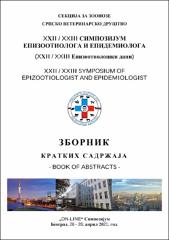Ispitivanje humoralnog imunološkog odgovora različitim serološkim metodama kod goveda nakon vakcinacije protiv virusa bolesti kvrgave kože

View/
Date
2021-04-26Author
Samojlović, Milena
Lazić, Sava
Živulj, Aleksandar
Lupulović, Diana
Lazić, Gospava
Polaček, Vladimir
Hollub, Christian
Loitsch, Angelika
Petrović, Tamaš
Metadata
Show full item recordAbstract
Lumpy skin disease (LSD) is a contagious disease of cattle of high economic importance caused by Capripoxvirus. Serological diagnostic of lumpy skin disease virus (LSDV) is challenging because the cell-mediated immunity plays a main role in immune response of infected animals and antibodies may be present in undetectable (too low) levels for currently available serological tests, as well. VNT is the gold standard and only validated serological test by OIE, however it lasts up to 9 days. Commercially available ELISA test has been developed but has not been recommended by OIE yet. Therefore, we performed comparative study on different serological tests for detection of humoral immune response in cattle after vaccination with attenuated LSDV vaccine. The tests used in this study included a modified 3-day long VNT established and performed at Scientific veterinary institute „Novi Sad“ Serbia (NIV-NS), a 4-day long VNT performed at AGES Moedling, Austria and commercial ELISA test (ID Screen Capripox Double Antigen Multispecies, IDvet, France). In November 2016, 90 sera samples were collected from cows vaccinated with attenuated LSDV vaccine in August 2016, while 35 sera samples were collected in September 2018 from cows vaccinated in August 2016, 2017 and 2018. All samples were tested by ELISA and VNT at Scientific veterinary institute „Novi Sad“, Serbia, while 90 samples were additionally tested at AGES, Moedling, Austria by VNT. Out of 90 samples specific antibodies against LSDV were detected in 30% by ELISA, 31% by AGES VNT and by NIV-NS VNT. Positive correlation was seen between S/P values in ELISA and titer values in both VNT, despite different cell line and virus strain. In 35 additional sera samples tested only at NIV-NS, positive result was found in 46%, while in 49% by VNT. The correlation between S/P values and titre values was also positive. In conclusion, it was not possible to detect antibodies against LSDV in all vaccinated cows by either of the tests used. All tests showed similar results and can be used for the detection of antibodies against LSDV. Commercial ELISA can be used in detection of antibodies against LSDV especially for large-scale testing because it is more usable for mass testing, robust, and not as time-consuming and labour-intensive as VNT.
